Visit
The first thing I will have to do when I visit the policy maker is to present the problem in such a way that it attracts her attention. That is why I will start with the description of the issue and its significance for the nursing profession for her to realize what impact her participation may have.
I will explain to her that despite the fact that depression and other psychological problems in adolescents were ignored for many centuries being treated as non-existent, a lot of researchers of today try to investigate the disorder, fully acknowledging that it is as real and severe as in adults. Yet, not enough is done to address this threatening condition in schools. The success of the outcome is highly important to nursing since depression may not only deteriorate teenagers and their parents’ relationships and quality of life but also lead to increasing morbidity and mortality rates among this population group (Parker, 2013).

Reasons for the Visit
- nothing particular was done by policymakers to improve the situation;
- there are no depression prevention guidelines;
- none of the programs have been tested in a randomized trial;
- there is no regulation to oblige schools to conduct examinations;
- there is no way to detect the problem when it can be prevented;
- the number of teenage suicides is on the increase;
- unless the problem is resolved, human lives are at stake.
One of the major reasons for my visit is that nothing significant has been done yet by policymakers to improve the current situation and nothing has been proposed to detect the problem in due time. Despite the fact that there are two acts addressing suicide prevention (the Youth Suicide Prevention Act of 1987 and public Health Service Act of 1990); no guidelines have been developed to deal with depression among adolescents on the official level. None of the programs developed during various studies have been tested in a randomized trial, which implies that they are not evidence-based (Parker, 2013). No regulation obliges schools to conduct screenings, which makes the problem hard to detect.

Statistics
- there is no timely diagnosis;
- 30% of depressed adolescents are not recognized;
- the condition may develop into bipolar disorder;
- 9% of teenagers meet the criteria for depression;
- 20% of them state they suffer from it since their early years;
- none of them receive due support from their schools.
The major problem surrounding depression among adolescents is that they are rarely diagnosed in time and therefore do not receive treatment they need. More than 30% cases are not recognized. Their condition may develop from stress and sadness to bipolar disorder, which cannot be reversed unless it is detected in due time (Parker, 2013). According to different studies, approximately 9% of high school students meet all the criteria for depression. More than 20% of them claim that they have been suffering from the condition since their early childhood (Allison, Nativio, Mitchell, Ren, & Yuhasz, 2014).

Goals
- To oblige schools to perform regular screenings to detect the condition in due time;
- To separate students with depression symptoms from those who are not affected;
- To form suicide risk groups;
- to create a list of depression indicators on the basis of the observed cases for teachers and parents to be able to identify the problem at an early stage;
- to identify other learning conditions to those whose depression is getting aggravated due to the unfavorable environment;
- to provide psychotherapy to adolescents suffering from various forms of depression based on the gravity of the condition;
- to ensure follow-up and cooperation with parents.
In order to attract the attention of Janice Kerekes (my policy maker), I will have to not only describe the problem and its significance to my profession but also present a clear and comprehensible list of goals that I want to achieve through the policy that will have to be introduced. This way, it will be made clear for her why the issue is worth spending time and financial resources.
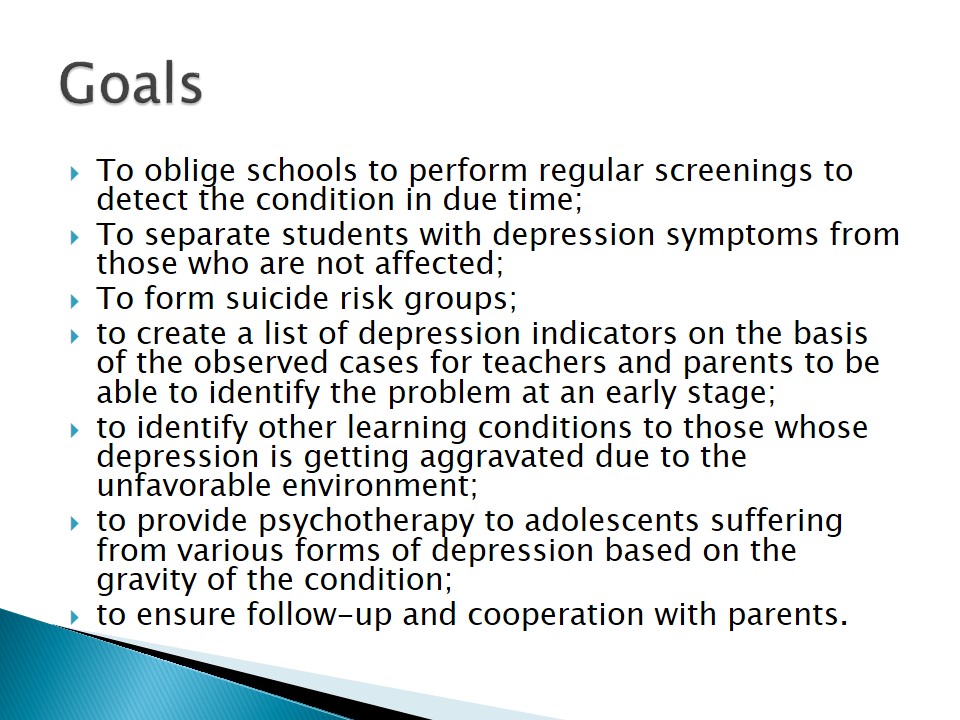
Proposed Solution
The best possible solution that I am going to present to the policy maker is to issue a new regulation for educational institutions that would oblige them to take part in a depression screening program for adolescents. At the first stage of it, students attending high school will need to complete an evaluation form, the major purpose of which is to find out if there are any who can be included in the risk group. At the second stage, this group will be further evaluated with the help of more elaborated computer tests. At the final stage, a school nurse will conduct personal interviews with those whose results raise concerns in order to identify their stage of psychological disorder or depression.
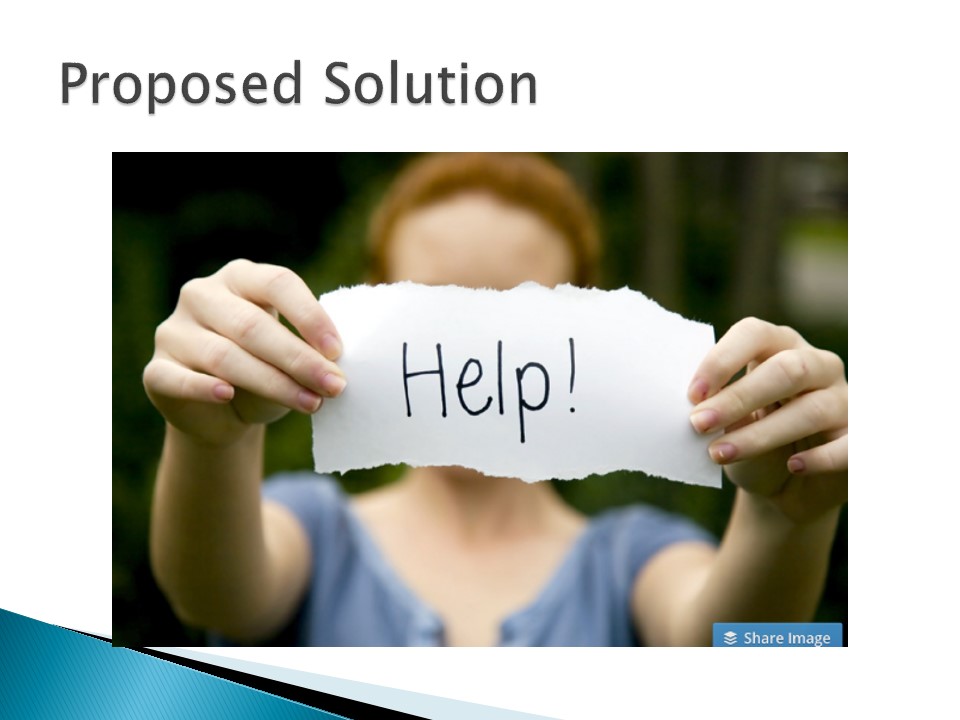
Policy Maker Response: Questions
- What tools are required to conduct the screenings?
- Who is going to be responsible for the procedure?
- Will the results be documented?
- Will parents and school authorities be informed about the results?
- What steps will be taken after the test?
- What treatment will teenagers receive?
Before discussing the actual process of the project implementation, the policy maker first asked me to clarify some issues. First and foremost, she was interested in the tools that will have to be provided to perform screenings. Second, she asked about the process of result documentation and their dissemination to the key stakeholders (parents and school authorities). Third, she was interested in the steps taken after the test. Finally, her biggest concern was that treatment that the teenagers are going to receive.

Policy Maker Response: Steps
- to provide schools with psychometrically validated screening tools;
- to introduce annual screening for high-school students;
- to ensure that nurses working in schools are able to perform the due procedures;
- to oblige schools to document the results;
- to introduce depression-managing programs for adolescents;
- to provide medications for those who cannot be treated with the behavior therapy only.
Since the policy maker was eager to assist me in the implementation of the project, the second thing she asked me to do is to clearly indicate the steps that were to be performed to achieve the goals mentioned in the presentation. She agreed to provide schools with psychometrically validated screening tools that must be tested as per their sensitivity (the ability to detect students with depression), specificity (the ability of identifying those who do not have any related conditions), positive predictive value (the relation between whose who screen positive and who are actually positive), and negative predictive value (the relation between whose who screen negative and who are actually negative). It was also important to ensure that nurses performing the screenings will be qualified enough to interpret the results correctly.
Other steps were connected with the work of nurses, result documentation, and administration of medications. It is highly necessary not only to perform the tests but also to document the results properly. The policy maker required to collect statistics to ensure that the proposed policy is effective enough to identify depression cases and to assess students of what age and gender are subject to the condition. Furthermore, she also said that screening was only the first step to be made. The most important part is to provide treatment to those whose state of mental health raises concerns. We agreed that behavior therapy was the most effective option. However, in the most severe cases, medication prescription may be required.
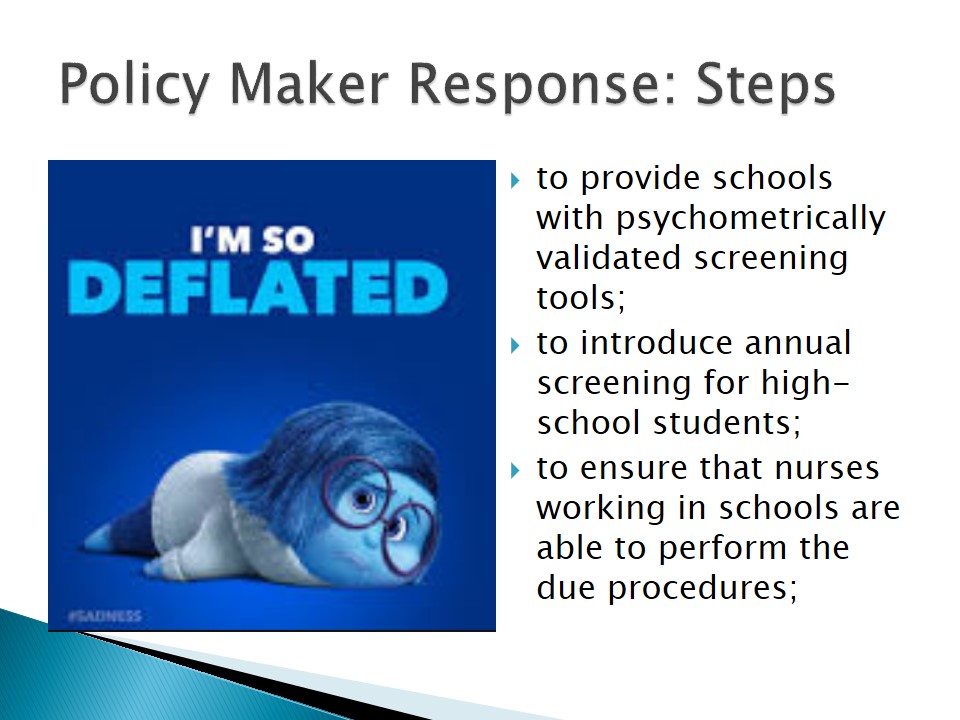
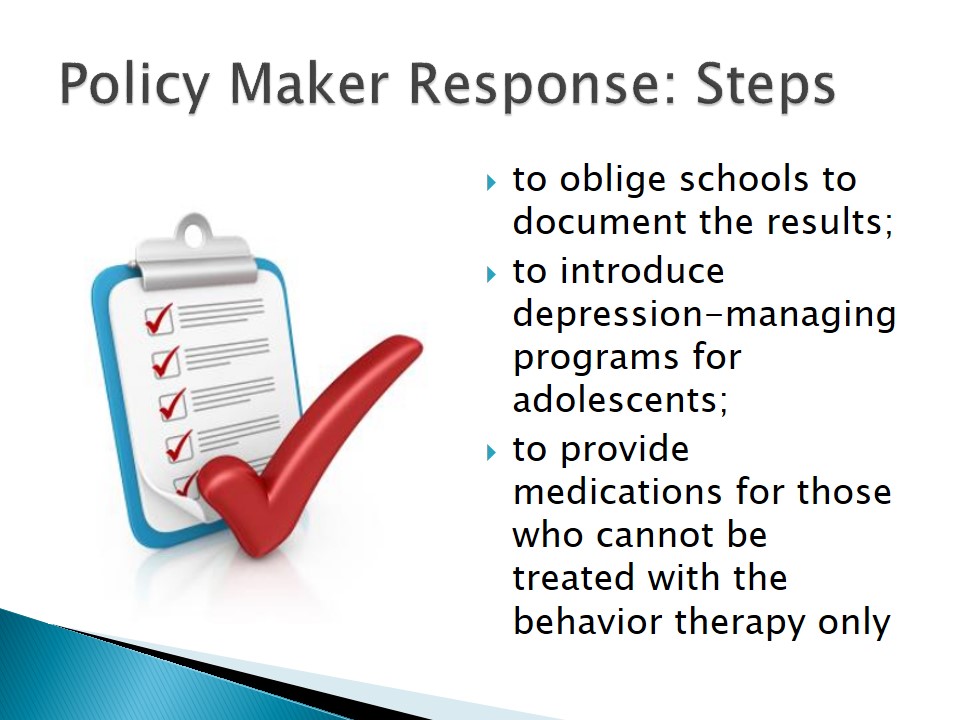
Reflections on Process: Follow-Up
The process of preparing the arguments for the policy maker and discussing the selected priority made me evaluate the alternative solutions to identify what follow-up actions will be the most appropriate. I came to the conclusion that there are actually three major options for schools to choose from: 1) to include problem education into the curriculum programs; 2) to provide training for teachers; 3) to introduce regular screening.
Despite the fact that the first one has been researched more profoundly, its effectiveness is still dubious. On the contrary, there is evidence that curriculum programs do not manage to prevent depression or suicidal behavior in high school students as they do not connect theoretical education with their real-life condition (Prochaska, Le, Baillargeon & Temple, 2016). Furthermore, a lot of them try to conceal their state being afraid of bullying (Bauman, Toomey, & Walker, 2013).
The second option, in-service training for teachers, can assist them in identifying teenagers at risk; yet, there is little research on the efficacy of the measure (Cunningham & Suldo, 2014). Besides, the judgment of a person without proper education can be subjective.
That is why the third option was chosen as the most appropriate one since it provides comprehensive evaluation of students’ state including self-reported data, results tests, and interviews (Prochaska et al., 2016).

Reflections on Process: Insights
The major insights gained about the problem of depression and the process of participating in policy making include:
- the issue of teenage depression is so grave that cannot be addressed without the interference of the authorities;
- depression screening must be introduced officially nationwide;
- it is the responsibility of every nurse to take part in policy making;
- the results of a policy-making visit may affect numerous educational institutions; therefore, it has to be carefully prepared;
- in order to influence the policy maker, it is not enough to cite arguments–the idea is to appeal both to logical reasoning and feelings.
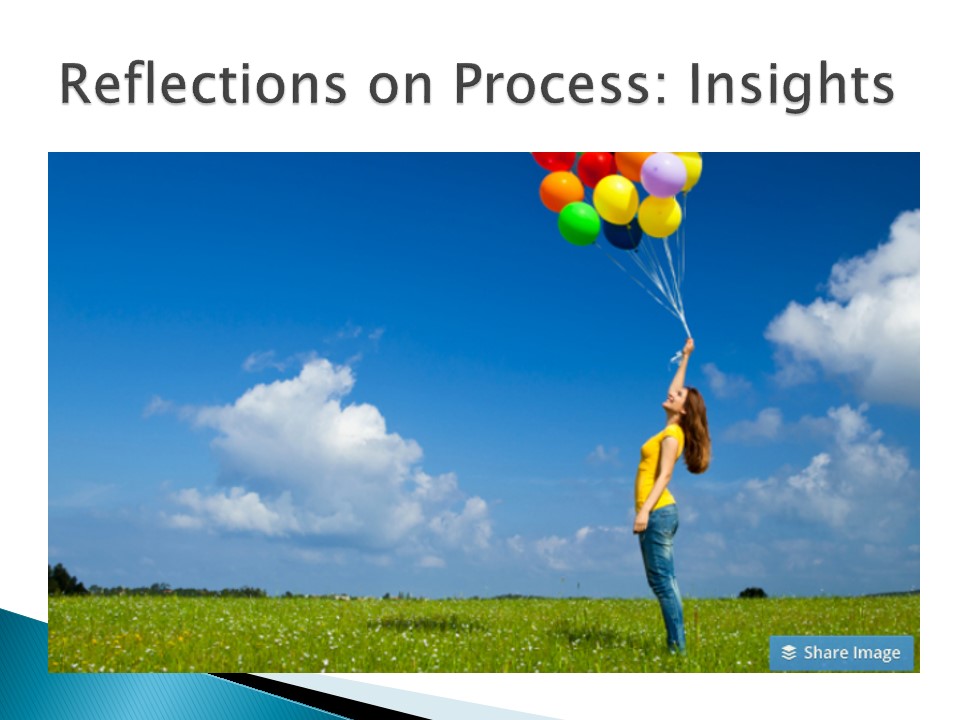
Future Opportunities
- introduce a national depression prevention program;
- resolve the problem of depression;
- prevent long-term consequences;
- increase the influence of nurses on policy-making.
The major future opportunity presented by the visit is to introduce a national depression prevention and detection program operating not only in schools but in all other educational institutions. It will allow resolving the problem of depression among children, teenagers, and young adults as regular screenings will detect it in due time. As for nurses, they will be able to prevent long-term negative consequences of the condition (poor state of health, low performance indicators in future work, impeded socialization, bad family relations, etc.). In the long run, it implies that they will not have to deal with the population suffering from a whole range of psychological diseases. Besides, it will increase the influence of nurses on policymaking as well as their prestige and decision-making power.
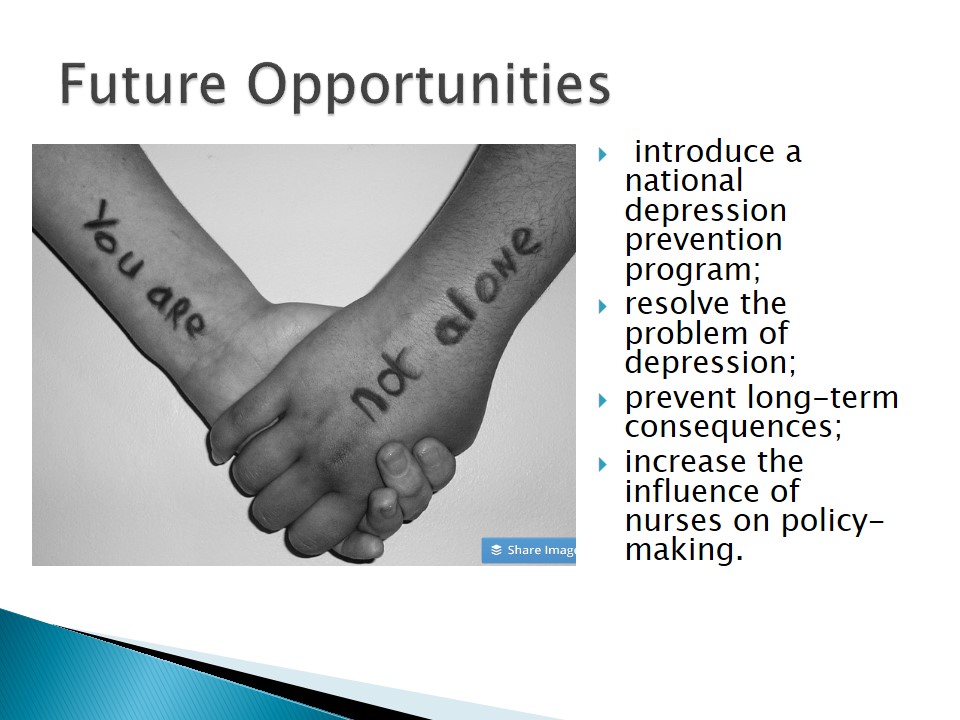
Conclusions
There is a nationwide problem with detection, treatment, and prevention of teenage depression. For nurses, it means that the quality and nature of care delivery may be negatively affected by the rong diagnosis. Since the problem is fraught with long-term consequences, due-time screening is crucial for schools to introduce. Even one policy-making visit can determine how the young generation will be able to ensure further development of a healthy society.
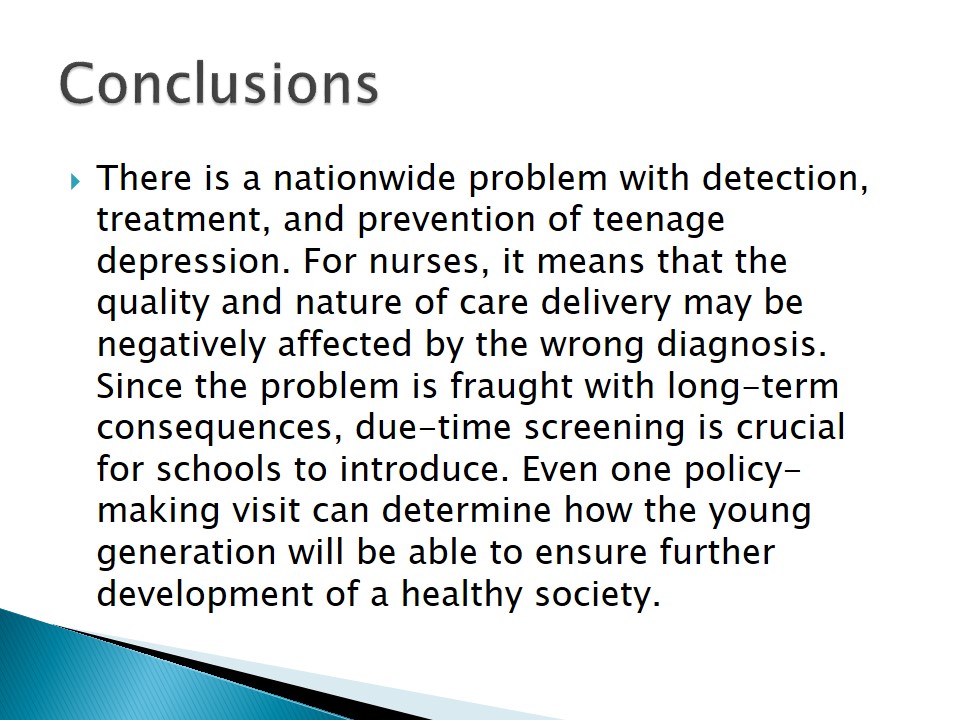
References
Allison, V. L., Nativio, D. G., Mitchell, A. M., Ren, D., & Yuhasz, J. (2014). Identifying symptoms of depression and anxiety in students in the school setting. The Journal of School Nursing, 30(3), 165-172.
Bauman, S., Toomey, R. B., & Walker, J. L. (2013). Associations among bullying, cyberbullying, and suicide in high school students. Journal of Adolescence, 36(2), 341-350.
Cunningham, J. M., & Suldo, S. M. (2014). Accuracy of teachers in identifying elementary school students who report at-risk levels of anxiety and depression. School Mental Health, 6(4), 237-250.
Parker, G. (2013). Teenage depression: Some navigational points for parents and professionals. World Psychiatry, 12(3), 272-274.
Prochaska, J. D., Le, V. D., Baillargeon, J., & Temple, J. R. (2016). Utilization of professional mental health services related to population-level screening for anxiety, depression, and post-traumatic stress disorder among public high school students. Community Mental Health Journal, 52(6), 691-700.